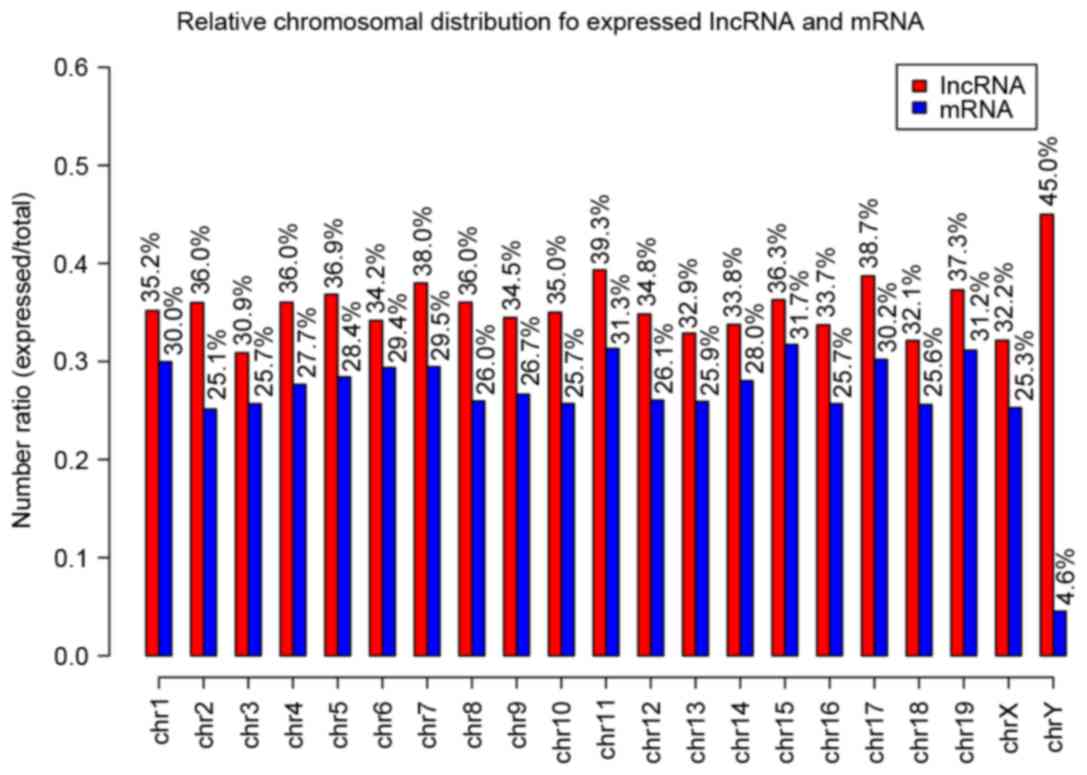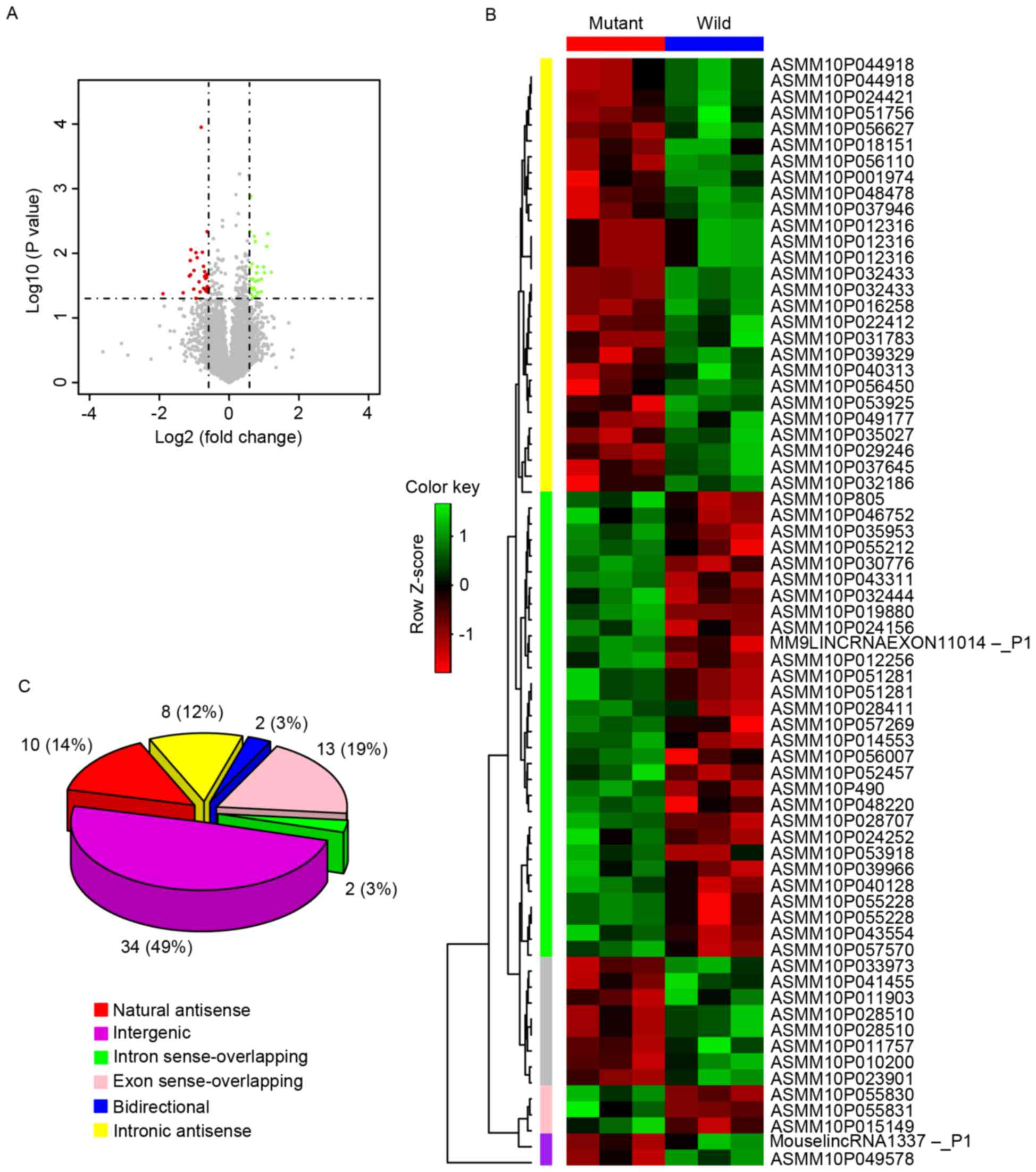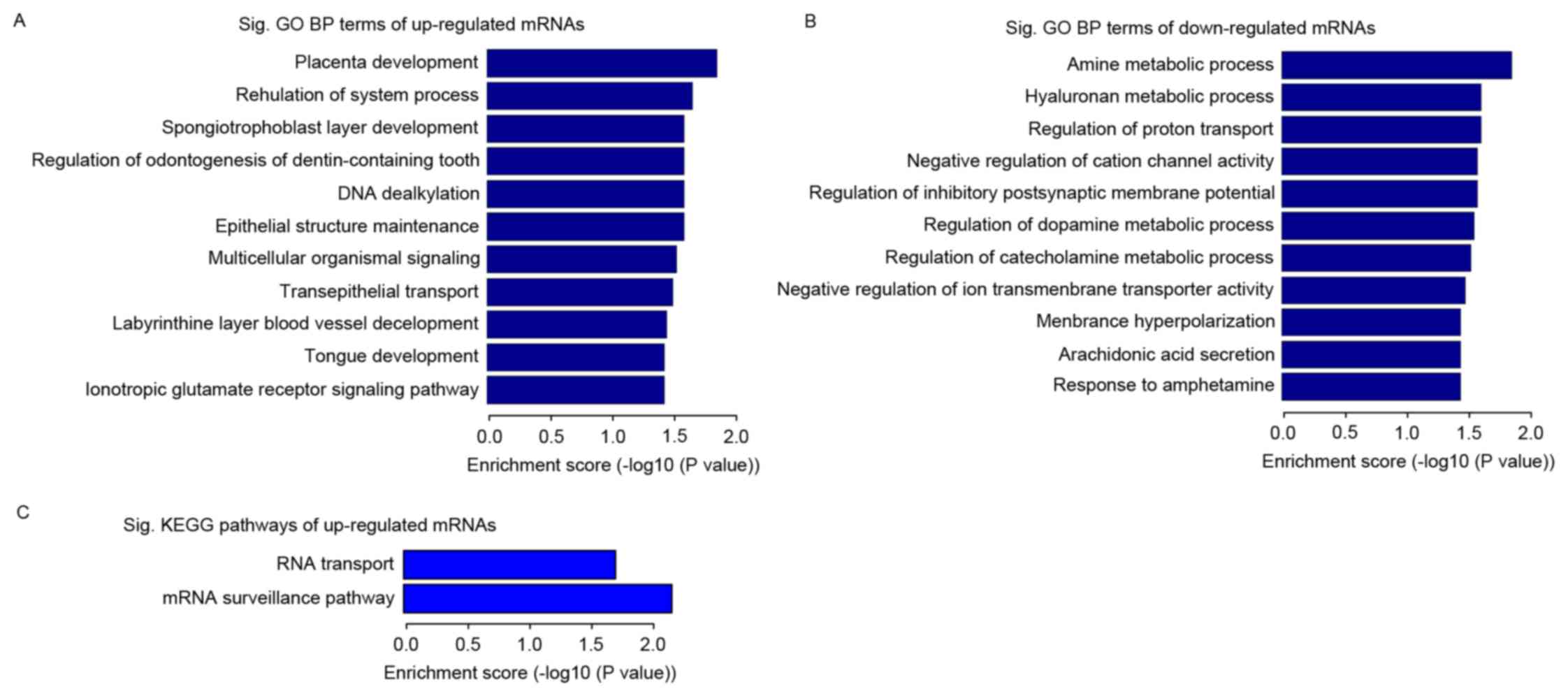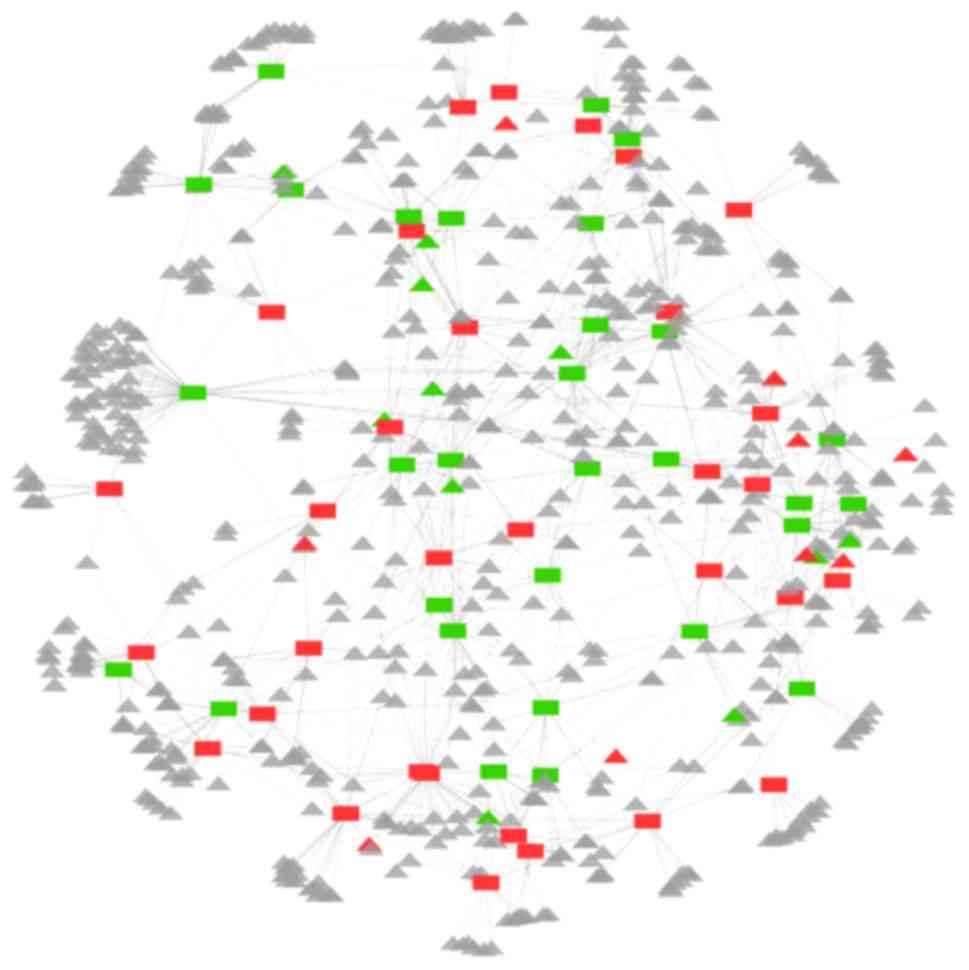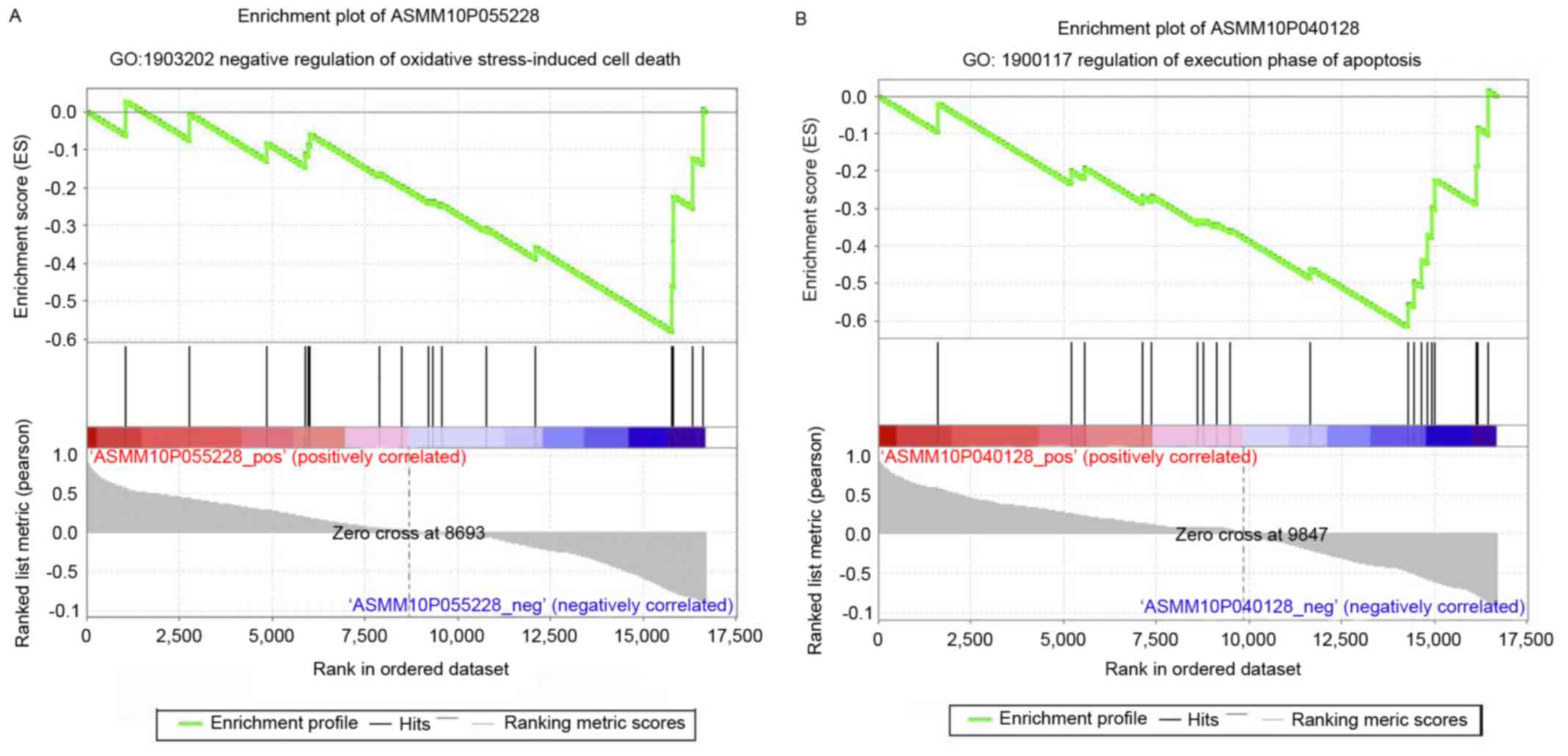Microarray expression profile analysis of long non-coding RNAs in optineurin E50K mutant transgenic mice
- Authors:
- Published online on: June 8, 2017 https://doi.org/10.3892/mmr.2017.6722
- Pages: 1255-1261
-
Copyright: © Li et al. This is an open access article distributed under the terms of Creative Commons Attribution License.
Abstract
Introduction
Glaucoma is a neurodegenerative ocular disease, which is recognized worldwide as the key causal factor in irreversible blindness (1). The predominant form of glaucoma is primary open-angle glaucoma (POAG). There are multiple genetic factors, which are significant in the etiology of glaucoma. There are >20 genetic loci associated with POAG, however, only a few of these have been identified, including myocilin, WD-repeat domain 36, optineurin (OPTN), and TANK-binding kinase-1 (2,3). The OPTN gene mutations, which encode amino acid substitutions including R545Q, E50K and H486R, have been linked to POAG and normal-tension glaucoma (NTG) (4–7). In a previous study, it was shown that, in transgenic mice models, the OPTN (E50K) mutation was the key element leading to the apoptosis of retinal ganglion cells, however, the specific mechanism remains to be fully elucidated (8).
Long noncoding RNAs (lncRNAs) are defined as structurally resembling mRNAs and transcribing >200 nucleotides, but not encoding proteins. These lncRNAs have been considered to be transcriptional noise; however, increasing evidence suggests that lncRNAs are important regulators governing various biological processes (BPs), including genomic imprinting, transcription activation and inhibition, chromatin modification, and tissue development (9). POAG is a complicated pathological process, which mediates the gene regulatory network. The latent function of lncRNAs in the retina of OPTN (E50K) transgenic mice remains to be elucidated. The present study analyzed the expression profile of differentially expressed lncRNAs in OPTN (E50K) transgenic and wild-type mice. It was found that eight lncRNAs were annotated in the GO BPs, and two of these eight lncRNAs, ASMM10P055228 and ASMM10P040128, were annotated with negative regulation of oxidative stress-induced cell death and regulation of execution phase of apoptosis, which may be the underlying mechanism for POAG.
Materials and methods
Animals and sample collection
All animal experiments were performed according to the guidelines of the National Institutes of Health and Regulations on the Care and Use of Laboratory Animals (National Institutes of Health, Bethesda, MA, USA). The retinas from 8-month-old transgenic and wild-type mice were collected. The retinas from six transgenic and wild-type mice were divided into three groups (E1, E2 and E3) and (W1, W2 and W3), respectively and were analyzed independently for the expression of lncRNAs.
RNA extraction
Total RNA from each sample was extracted using TRIzol reagent, and quantified using a NanoDrop ND-1000 spectrophotometer; and RNA integrity was evaluated using standard denaturing agarose gel electrophoresis.
Microarray analysis
The expression profiles of the genome-wide mRNA and lncRNAs of the mice were examined using Arraystar mouse lncRNA microarray version 3.0, designed for the profiling of mouse genome-wide lncRNAs and protein-coding transcripts, performed by KangChen Biotech Co., Ltd. (Shanghai, China). This microarray contains 35,923 lncRNAs collected from the National Center for Biotechnology Information Refseq, UCSC, Ensembl, RNAdb 2.0, Fantom3, ncRNA expression databases, and from previous literature. A total of 24,881 coding transcripts were extracted based on the Collaborative Consensus Coding Sequence (CCDS) public source.
The microarrays were performed using an Agilent scanner (G2505C; Agilent DNA microarray scanner; Agilent Technologies, Inc., Santa Clara, CA, USA) and the captured array images were analyzed using Agilent feature extraction software (version 11.0.1.1; Agilent Technologies, Inc.). The GeneSpring GX v12.1 software package (Agilent Technologies, Inc.) was used to perform quantile normalization and subsequent data processing. Following normalization, mRNAs and lncRNAs, in which at least three of the six samples contained flags in present or marginal (‘All Targets Value’) were selected for subsequent data analysis.
Gene ontology (GO) and pathway enrichment analysis
GO analysis bonding was used to associate the differentially expressed mRNAs with GO function terms. The threshold for significant GO terms was P=0.05. The mRNAs were considered to have a higher level of association with the GO term if its P-value was lower. The enrichment pathways of the differentially expressed mRNA were identified using the Kyoto Encyclopedia of Genes and Genomes (KEGG) database with Fisher P<0.05. The GO and KEGG enrichment analyses were performed using the Database for Annotation, Visualization and Integrated Discovery (DAVID; https://david.ncifcrf.gov/).
Establishment of the lncRNA and mRNA co-expression network. The lncRNA-mRNA co-expression pairs were based on the normalized signal intensity of microarray data for the mutant and wild-groups. Pearson's correlation coefficients (PCCs) were used to calculate the correlation between lncRNA and mRNA pairs for all combinations among all the differentially expressed lncRNAs and mRNAs. The pairs with PCC values ≥0.95 or ≤-0.95 and with P<0.01 were selected as linkages in the network, and were considered to be significantly correlated pairs. The lncRNA and mRNA co-expression network was constructed using Cytoscape software version 3.3.0 (http://www.cytoscape.org/) (10).
GO BP prediction of the differentially expressed lncRNAs
The GO BPs of the differentially expressed lncRNAs were predicted using a computational method, gene set enrichment analysis (GSEA) (11). This method interprets gene expression data by focusing on gene sets, which share common biological function, chromosomal location or regulation. The expression level of each differentially expressed lncRNA was considered as a profile and correlated with all protein-coding genes of the microarray by computing the PCCs. For each lncRNA, a list of correlation-based ranked protein-coding genes was constructed. In the present study, GSEA was based on the mice GO BP-relevant gene sets. These gene sets were obtained from enrichment mapping (mice_GO_bp_with_GO_iea_entrezgene.gmt; http://baderlab.org/GeneSets, Accessed February 24, 2015), which covers 13,190 GO BP terms, with corresponding genes representing the gene set for each GO term. This ranked list was used to calculate an enrichment score, which is a running sum beginning from the highest correlating gene, and the significant gene sets were identified using the weighted Kolmogorov-Smirnov test. To obtain the false discovery rate P-values, the gene sets were permuted 1,000 times to obtain 1,000 random gene sets. Any gene set of GO BP terms with a family-wise error rate P<0.05 was determined to be significantly associated with the corresponding lncRNA, and the GO BP was considered to be a predicted BP of that particular lncRNA.
Statistical analysis
The expression levels of lncRNA and mRNA between the mutant and wild-groups were compared using a two-tailed t-test. Differentially expressed lncRNAs and mRNAs with statistical significance between the two groups were defined as the genes with absolute fold change ≥1.5 and P<0.05. Hierarchical clustering was performed using R software version 3.1.3 (www.r-project.org).
Results
Overview of lncRNA and mRNA profiles
The microarray evaluated in the present study contained 35,923 lncRNA probes collected from updated databases and literature, and 24,881 mRNA probes based on the public source, CCDS. The expression profiles of the lncRNA and mRNA are shown in Table I. Only 0.74% of the expressed lncRNAs (69/9,386) were significantly differentially expressed, whereas 0.57% of the expressed mRNAs (40/7,051) were significantly differentially expressed in the two groups (Table I).
As shown in Fig. 1, the distribution of the expressed probes in all the chromosomes of the lncRNAs and mRNAs were determined. For the chromosome distribution of mRNA, the ratio of the expressed probes/total probes of each chromosome was similar with a range of 20–30%, with the exception of the Y chromosome ratio of only 4.6%. The chromosome distribution of the lncRNA profile was similar, with a range of 30–40%.
Differentially expressed lncRNAs in mutant and wild-type mice
According to the lncRNA expression profiles, among the 9,386 probes with expression signals above that of background noise, only 69 lncRNAs were differentially expressed (absolute fold change >1.5 and P<0.05) between the mutant and wild-mice (Fig. 2A). Among the 69 differentially expressed lncRNAs, 37 lncRNAs were identified as being downregulated and 32 lncRNAs were upregulated with statistical significance in the mutant mice. The unsupervised hierarchical clustering of the 69 differentially expressed lncRNAs for the mutant and wild-types showed that the expression values of each lncRNA in the three samples of the same group were similar, whereas the expression values of each lncRNA in the six samples of the two groups were different (Fig. 2B). The 69 differentially expressed lncRNAs in the two sets of mice samples contained 10 natural antisense (five upregulated and five downregulated), 34 intergenic (17 upregulated and 17 downregulated), eight intronic antisense (four upregulated and four downregulated), two introns (upregulated), 13 exon sense-overlapping (two upregulated and 11 downregulated) and two bidirectional sequences (upregulated), as shown in Fig. 2C.
Differentially expressed mRNAs in mutant and wild-type mice
Among the differentially expressed mRNAs, the number of the upregulated mRNAs (25/40) was almost twice that of the downregulated mRNAs (15/40). The upregulated mRNAs were enriched in several GO terms with statistical significance, with the two most prominent BP terms being placenta development and regulation of system process (Fig. 3A). The downregulated mRNAs were also enriched in several GO terms, including the amine metabolic and glycosaminoglycan biosynthetic processes in BP (Fig. 3B). The analysis performed by mapping genes of the KEGG pathway showed that the upregulated mRNAs were enriched in two KEGG pathways, mRNA surveillance pathways and RNA transport (Fig. 3C), whereas no enriched KEGG pathways were identified for the downregulated mRNAs. These two KEGG pathways contained the two upregulated mRNAs, apoptotic chromatin condensation inducer 1 and nuclear RNA export factor 7.
Determination of the lncRNA and mRNA coexpression network
Coexpression network analysis was performed between the lncRNAs and mRNAs (Fig. 4). The correlation between the 69 differentially expressed lncRNAs and all mRNAs were determined, which revealed 1,670 connections above the threshold, including the lncRNA-lncRNA and lncRNA-mRNA pairs. The network contained 719 nodes with 62 differentially expressed lncRNAs, comprising 32 downregulated and 30 upregulated lncRNAs, and 656 mRNAs involved in the coexpression network. For the 656 mRNAs in the network, there were nine downregulated mRNAs (Bcdin3d, creatine kinase muscle, dopamine receptor D4, enamelin, flavin containing monooxygenase 9, hyaluronan synthase 1, ring finger protein 128, spindlin family member 4 and WAS/WASL-interacting protein family member 2) and 11 upregulated mRNAs (4933411K20Rik, butyrylcholinesterase, F-Box and WD repeat domain containing 8, killer cell lectin-like receptor subfamily A, leucine zipper and EF-hand containing transmembrane protein 2, mohawk homeobox, Nxf7, olfactory receptor 1138, PHD finger protein 7, Svop-like and zinc finger protein 451) among the 40 differentially expressed mRNAs in the microarray. These deregulated mRNAs were connected with 38 differentially expressed lncRNAs.
Prediction of differentially expressed lncRNA functions through the associated mRNA
The analysis of the 69 differentially expressed lncRNAs revealed a set of eight lncRNAs associated with distinct and diverse GO BP terms with statistical significance (ASMM10P055228, ASMM10P040128, ASMM10P056450, ASMM10P040313, ASMM10P044918, ASMM10P039329, ASMM10P024421 and ASMM10P037946). The set of annotated lncRNAs contained six downregulated and two upregulated lncRNAs (Table II).
Table II.GO biological process prediction of the differentially expressed long non-coding RNAs by gene set enrichment analysis. |
Discussion
At present, the OPTN (E50K) mutation of is the only mutation to be identified as one of the origins of NTG pathogenesis (12). The overexpression of OPTN (E50K) in transgenic mice provides a model system to investigate the molecular mechanisms causing POAG (8). The deregulation of lncRNAs has been associated with the susceptibility to certain human diseases, including cancer, neurological disease, cardiovascular disease and glaucoma (13). However, the role of lncRNAs in OPTN (E50K) transgenic mice has not been investigated. The results of the present study are the first, to the best of our knowledge, to reported the expression profile of lncRNAs in OPTN (E50K) transgenic mice and show that the function of lncRNAs may be novel biomarkers for POAG.
In comparing the expression profiles of lncRNAs and mRNAs, the lncRNAs had a smaller percentage of significantly expressed signals above background expression. However, the number of differentially expressed lncRNAs was higher, compared with the number of differentially expressed mRNAs; and it was revealed that the lncRNAs may perform more important functions in the mutant mice, compared with mRNAs. It was found that lncRNAs exhibited increased spatially and temporally-regulated expression patterns, compared with protein-coding genes.
In terms of the chromosome distribution of the mRNAs, the ratio of expressed probes/total probes for each chromosome was similar, with a range of 20–30%, with the exception of the Y chromosome with a ratio of only 4.6%. The chromosome distribution of the lncRNA profile was similar with these findings, with a marginally higher range of 30–40%, with the exception of the Y chromosome with a higher ratio, compared with that in the mRNA profile. These results suggested that the lncRNAs of the Y chromosome may have had a relatively important role in the mutant mice.
In the present study, prediction of differentially expressed lncRNA functions among the eight annotated lncRNAs, revealed two in subset 1 (ASMM10P055228 and ASMM10P040128), which were annotated with the GO BP, negative regulation of oxidative stress-induced cell death, and regulation of execution phase of apoptosis, respectively (Fig. 5A and B). These two GO terms are associated with cell death or apoptosis. The other six lncRNAs were included in subset 2, and were annotated with seven GO BP terms. Among the six lncRNAs in subset 2, three lncRNAs were annotated with BPs relevant to the nervous system, corresponding with three GO BP terms. The patterns may be involved in similar BPs. Therefore, based on the above, the differentially expressed lncRNAs in the same subset may have the similar biological functions with similar expression patterns. The annotation of ASMM10P055228 and ASMM10P040128 with the negative regulation of oxidative stress-induced cell death and regulation of execution phase of apoptosis, indicate this may be the mechanism underlying POAG.
Investigations are ongoing following those of the present study, and the potential mechanism underlying the observations remains preliminary. Therefore, future investigations are required, focusing on the functional evaluations, to further clarify the pathogenetic molecular pathways, and analyze the effect of different lncRNAs on POAG. The findings of the present study may increase knowledge regarding the function of lncRNAs for detecting the pathogenesis of POAG.
Acknowledgements
The present study was supported by the State Natural Sciences Foundation (grant nos. 81271000 and 81470634).
References
|
Quigley HA and Broman AT: The number of people with glaucoma worldwide in 2010 and 2020. Br J Ophthalmol. 90:262–267. 2006. View Article : Google Scholar : PubMed/NCBI | |
|
Fingert JH: Primary open-angle glaucoma genes. Eye (Lond). 25:587–595. 2011. View Article : Google Scholar : PubMed/NCBI | |
|
Fuse N: Genetic bases for glaucoma. Tohoku J Exp Med. 221:1–10. 2010. View Article : Google Scholar : PubMed/NCBI | |
|
Rezaie T, Child A, Hitchings R, Brice G, Miller L, Coca-Prados M, Héon E, Krupin T, Ritch R, Kreutzer D, et al: Adult-onset primary open-angle glaucoma caused by mutations in optineurin. Science. 295:1077–1079. 2002. View Article : Google Scholar : PubMed/NCBI | |
|
Aung T, Rezaie T, Okada K, Viswanathan AC, Child AH, Brice G, Bhattacharya SS, Lehmann OJ, Sarfarazi M and Hitchings RA: Clinical features and course of patients with glaucoma with the E50K mutation in the optineurin gene. Invest Ophthalmol Vis Sci:. 46:2816–2822. 2005. View Article : Google Scholar : PubMed/NCBI | |
|
Leung YF, Fan BJ, Lam DS, Lee WS, Tam PO, Chua JK, Tham CC, Lai JS, Fan DS and Pang CP: Different optineurin mutation pattern in primary open-angle glaucoma. Invest Ophthalmol Vis Sci:. 44:3880–3884. 2003. View Article : Google Scholar : PubMed/NCBI | |
|
Fuse N, Takahashi K, Akiyama H, Nakazawa T, Seimiya M, Kuwahara S and Tamai M: Molecular genetic analysis of optineurin gene for primary open-angle and normal tension glaucoma in the Japanese population. J Glaucoma. 13:299–303. 2004. View Article : Google Scholar : PubMed/NCBI | |
|
Chi ZL, Akahori M, Obazawa M, Minami M, Noda T, Nakaya N, Tomarev S, Kawase K, Yamamoto T, Noda S, et al: Overexpression of optineurin E50K disrupts Rab8 interaction and leads to a progressive retinal degeneration in mice. Hum Mol Genet. 19:2606–2615. 2010. View Article : Google Scholar : PubMed/NCBI | |
|
Ponting CP, Oliver PL and Reik W: Evolution and functions of long non-coding RNAs. Cell. 136:629–641. 2009. View Article : Google Scholar : PubMed/NCBI | |
|
Shannon P, Markiel A, Ozier O, Baliga NS, Wang JT, Ramage D, Amin N, Schwikowski B and Ideker T: Cytoscape: A software environment for integrated models of biomolecular interaction networks. Genome Res. 13:2498–2504. 2003. View Article : Google Scholar : PubMed/NCBI | |
|
Subramanian A, Tamayo P, Mootha VK, Mukherjee S, Ebert BL, Gillette MA, Paulovich A, Pomeroy SL, Golub TR, Lander ES and Mesirov JP: Gene set enrichment analysis: A knowledge-based approach for interpreting genome-wide expression profiles. Proc Natl Acad Sci USA. 102:15545–15550. 2005. View Article : Google Scholar : PubMed/NCBI | |
|
Iwase A, Suzuki Y, Araie M, Yamamoto T, Abe H, Shirato S, Kuwayama Y, Mishima HK, Shimizu H, Tomita G, et al: The prevalence of primary open-angle glaucoma in Japanese: The Tajimi Study. Ophthalmology. 111:1641–1648. 2004. View Article : Google Scholar : PubMed/NCBI | |
|
Wapinski O and Chang HY: Long noncoding RNAs and human disease. Trends Cell Biol. 21:354–361. 2011. View Article : Google Scholar : PubMed/NCBI |



